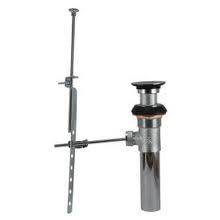 Sometimes a drain isn’t slow because there is a blockage in it, rather it may be that the sink stopper is set too low and doesn’t allow much water to pass. When you pull the rod upwards to lower the stopper, it may only move a fraction of an inch. This is all easy to repair.
Sometimes a drain isn’t slow because there is a blockage in it, rather it may be that the sink stopper is set too low and doesn’t allow much water to pass. When you pull the rod upwards to lower the stopper, it may only move a fraction of an inch. This is all easy to repair.
If you follow the lift rod downward under the sink, you will see a “V” shaped clip that holds it to a horizontal pivot rod. Squeeze the clip together and pull the vertical piece off of the horizontal rod. You should be able to move the pivot rod up and down and watch the stopper freely move up and down as well (if it doesn’t have much travel, you may have the wrong stopper in place).
Generally in this situation, you want to move the pivot rod to the next hole down from where it was. Place one leg of the clip on the horizontal pivot rod, then place the vertical lift rod on the horizontal rod, and then squeeze the clip together and place the other leg onto the horizontal rod. The tension from the clip keeps everything in place.
Test the movement of the stopper again. It should have more movement. If it still needs more adjusting, just repeat the steps until you are happy with the movement.
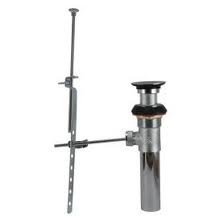 If your bathroom sink stopper won’t lift back up, there are a couple possibilities to check out. You will need to open the cabinet and look around. The simplest reason is that the clip that holds the lift rod (the thing you grab and pull) to the pivot rod (think of a teeter-totter that pushes the stopper up and down) has slipped off. If this has happened, look on the floor of the cabinet for a “V” shaped piece of metal with some holes in it. It may also still be attached to the lift rod and just barely hanging on.
If your bathroom sink stopper won’t lift back up, there are a couple possibilities to check out. You will need to open the cabinet and look around. The simplest reason is that the clip that holds the lift rod (the thing you grab and pull) to the pivot rod (think of a teeter-totter that pushes the stopper up and down) has slipped off. If this has happened, look on the floor of the cabinet for a “V” shaped piece of metal with some holes in it. It may also still be attached to the lift rod and just barely hanging on.
To reinstall the clip, slide one leg back on to the lift rod, thread the lift rod through a hole in the pivot rod, and then squeeze the legs of the clip together and slide it back on to the lift rod. This holds the pivot rod in place on the lift rod and doesn’t allow it to move.
The other likely reason the pop up won’t move is that the end of the pivot rod has broken. This end threads into the base of the pop up stopper and moves it. Over time this end will corrode and break off and will be unable to move the stopper. You can unscrew the nut at the back of the pivot rod and pull the rod out. Replace it by threading it back into the stopper, tightening the nut that holds it in place, and then reattaching it to the lift rod.
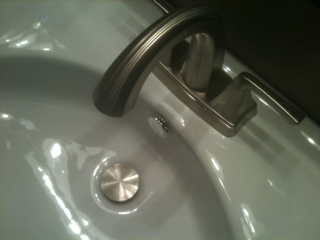 Some faucet manufacturers are no longer making the pull rod type drain stoppers. Instead, they are including a pop-up stopper that you simply push with your finger. Push the stopper once to stop the flow of water and fill the sink, and push it again to open the drain and allow the sink to drain.
Some faucet manufacturers are no longer making the pull rod type drain stoppers. Instead, they are including a pop-up stopper that you simply push with your finger. Push the stopper once to stop the flow of water and fill the sink, and push it again to open the drain and allow the sink to drain.
Design-wise it is a very clean look. Gone is the little knob behind the faucet to open and close the drain stopper. In my mind, however, it seems to be unsanitary to touch the drain stopper. I know what I put down my drain, and I certainly don’t want to touch it. Plus I don’t want to stick my hand into a sink full of grossness to push the stopper.
Installing this type of stopper assembly is very easy, and you won’t need tools….surprise here: most of the assembly is plastic. Remove the large nut (that holds the assembly to the bottom of the sink) and the conical washer. Drop the assembly through the top of the sink and into the hole for the drain. You won’t need to put any plumbers putty under it unless the manufacturer says to do so. Hold the assembly in place and install the conical washer back onto the tailpiece so that the large end faces down. Then just spin the nut back onto the threads. This nut will push the washer into the hold and seal out any leaks. You may have to give it another quarter turn if it leaks.
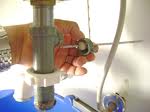 Have you ever lifted up the bathroom sink stopper and it just doesn’t move? There could be a couple of reasons for this.
Have you ever lifted up the bathroom sink stopper and it just doesn’t move? There could be a couple of reasons for this.
In most cases, when you want to stop the flow of water, you lift up on the handle. There is a pivot rod in the drain assembly that acts like a see-saw. When you lift the handle, it pulls one end of the pivot rod up and forces the other end (the one connected to the sink stopper) to go down. In most cases, if the sink stopper isn’t moving, the end of the pivot rod has corroded and needs to be replaced. There are a few other reasons like either the pivot rod has become separated from the lift handle, or even that the stopper is broken where the pivot rod connects to it.
Check the connections first, and then remove the cap nut that holds the pivot rod in place. Pull out the pivot rod and check the end. It is usually about 1 inch long, but it will likely be corroded and the end will have broken off. There are 2 sizes and so bring the old one with you to find a replacement. If things at the drain don’t look so good, you might even consider replacing the entire drain assembly, which costs about $15.00, and it will have all of the parts you need.
 If your sink stopper in your bathroom sink won’t raise back up, you likely have a broken pivot rod in the drain assembly. The sink stopper is plastic, and the pivot rod is made of metal. The pivot rod corrodes and the end, which is subjected to the stress of raising and lowering the sink stopper, breaks off. Gravity takes over and the sink stopper falls into the sink drain which stops the sink from draining.
If your sink stopper in your bathroom sink won’t raise back up, you likely have a broken pivot rod in the drain assembly. The sink stopper is plastic, and the pivot rod is made of metal. The pivot rod corrodes and the end, which is subjected to the stress of raising and lowering the sink stopper, breaks off. Gravity takes over and the sink stopper falls into the sink drain which stops the sink from draining.
This can all be corrected by replacing the pivot rod. The pivot rod goes through the end of the stopper on one side. The other side is connected to the handle on top of the faucet. When you lift the handle, the pivot rod engages the stopper and pulls it down to stop the flow of water. Pushing the handle down raises the stopper and allows water to pass.
You will have to disconnect the pivot rod from the handle and unscrew the cap nut that holds the pivot rod to the drain assembly. Pull the old one out and place the new pivot rod into the hole making sure to engage the sink stopper. You may have to slightly raise the stopper to engage it. Replace the cap nut and reconnect the lift handle and your problems should be solved.
 If the water drains very slowly down your bathroom sink, you probably have a clog between the sink stopper and the P-trap below the sink. Fortunately, this is one of the easier plumbing problems to fix.
If the water drains very slowly down your bathroom sink, you probably have a clog between the sink stopper and the P-trap below the sink. Fortunately, this is one of the easier plumbing problems to fix.
Bathroom sinks take a lot of abuse. Most of the clogs are simply hair mixed in with a little soap and they make a nice ball to slow the water. You can try a tool called a “zip-it” which is nothing more than a long skinny piece of plastic with small barbs on it. You slide this down in between the stopper and the drain and it snags the hair ball and pulls it out. This can get very nasty though as it sprays drain stew all over you and the sink as you pull it out. So pull it slowly and be aware.
You can also take apart the drain assembly, which sounds a lot worse that it is. The sink stopper handle is attached to a horizontal pivot rod. This pivot rod connects to the vertical drain by a nut. Unscrew the nut and pull out the pivot rod. This will allow you to pull the sink stopper out of the sink. You will probably pull out a ball of hair along with it. You can clean this up and reinstall everything back together. The drain should flow much better.
If the drain is still slow, disassemble the P-trap and dump out the water and debris. You will probably see a lot of hair hanging out of the drain (there the P-trap was connected). Remove this hair and reassemble everything back together.
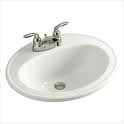 How many times have you cursed your plumbing? Many times I would expect. One of those times might deal with the sink stopper. When you pull up on the sink stopper handle to engage the stopper and it doesn’t stop the water. Instead, the handle just drops back down and the stopper lifts back up so that the water just runs down the drain.
How many times have you cursed your plumbing? Many times I would expect. One of those times might deal with the sink stopper. When you pull up on the sink stopper handle to engage the stopper and it doesn’t stop the water. Instead, the handle just drops back down and the stopper lifts back up so that the water just runs down the drain.
You are probably thinking that this is going to kill your weekend, but the reality is that it should take just a few seconds and likely the most difficult part will be getting access under the sink.
A sink stopper works like this: the sink stopper is connected to a pivot rod. This pivot rod has a ball on the end of it allowing it to move up and down. This up and down movement lifts and lowers the stopper. The other end of the pivot rod is connected to the handle. So when you lift the handle, the pivot rod pushes the stopper down closing off the drain. When you push the handle back down, the pivot rod lifts the stopper and allows the water to drain.
The problem is where the pivot rod ball attaches to the drain pipe. The pivot rod is held to this pipe by a cap nut. All you have to do is tighten this cap nut. If you over tighten it, the sink stopper won’t move freely, so tighten it to the point that the sink stopper will move but not so much that the stopper won’t stay in place.
 Have you ever pulled up on your bathroom sink stopper only to find nothing happens? It's time to get under the sink. Sink stoppers aren't the usual suspect, rather it's the parts that make them move. The knob you pull is attached to a pivot rod which goes into the drain pipe (actually called a "tailpiece" assembly) and connects to the sink stopper. So when you pull up on the knob the stopper should go down to stop water from running out of the sink. Usually, after years of sitting in a flow of water, the pivot rod corrodes and stops working. Fixing it will take about $12.00 of parts and about 15 minutes of your time.
Have you ever pulled up on your bathroom sink stopper only to find nothing happens? It's time to get under the sink. Sink stoppers aren't the usual suspect, rather it's the parts that make them move. The knob you pull is attached to a pivot rod which goes into the drain pipe (actually called a "tailpiece" assembly) and connects to the sink stopper. So when you pull up on the knob the stopper should go down to stop water from running out of the sink. Usually, after years of sitting in a flow of water, the pivot rod corrodes and stops working. Fixing it will take about $12.00 of parts and about 15 minutes of your time.
In the back of the tailpiece is a nut that holds the pivot rod into the sink stopper. Unscrew this nut and pull out the remnants of the pivot rod. I would take it to a home center and buy a new one as there are a few sizes and diameters. You may have to buy the entire drain assembly, which includes a new stopper, pivot rod, etc.
Simply push the new pivot rod into the hole of the sink stopper and tighten the not that holds it in place. You can play around with it so that it isn't too tight or too loose. Once you re-connect the pull rod (the knob that you pull up) you can make sure the tension is right. You can connect the pull rod using a spring clip that comes with the pivot rod. By the way, if you pull up on the knob, and the stopper won't stay down to hold water in the sink, you need to tighten the nut that holds the pivot rod to the tailpiece.